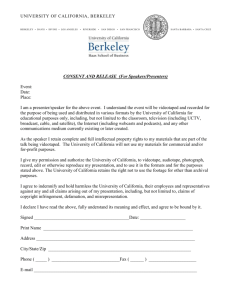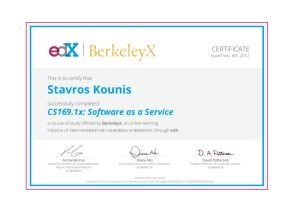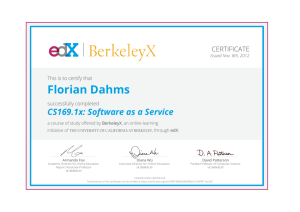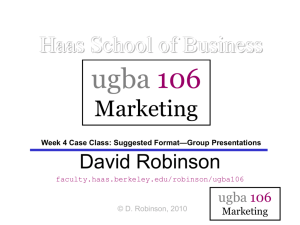Exchange Report – University of California, Berkeley
advertisement
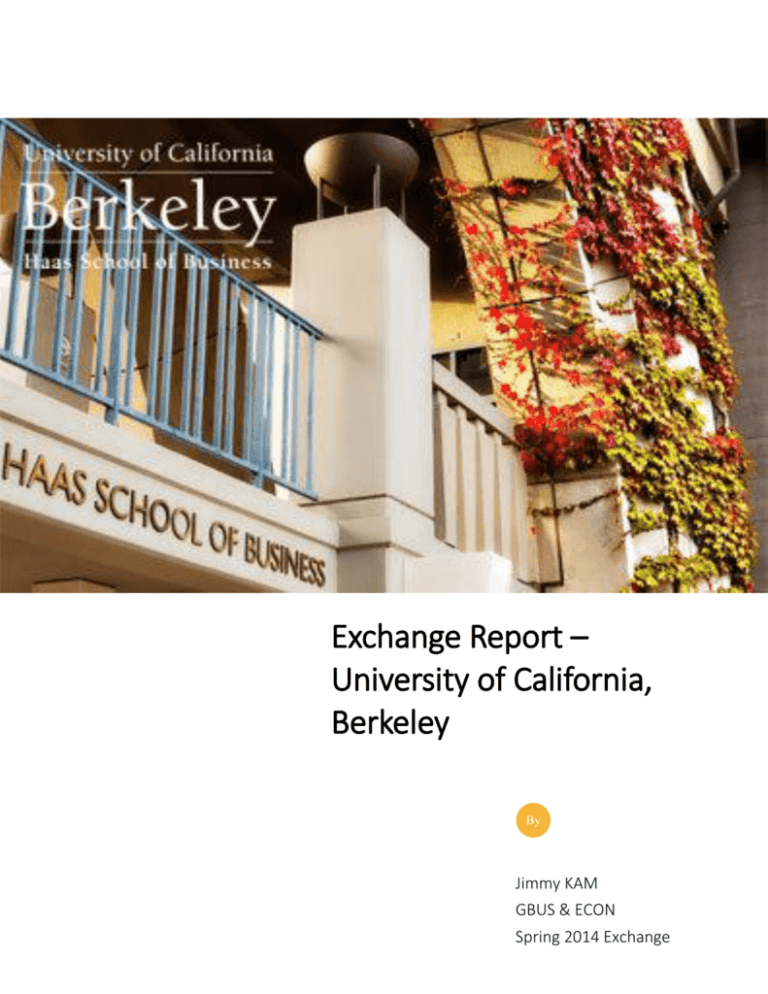
Exchange Report – University of California, Berkeley By Jimmy KAM GBUS & ECON Spring 2014 Exchange CONTENTS Part I – Monthly Activity Log ................................................................................................................ 2 Part II – General Exchange Information ............................................................................................... 3 Part III – Items to Bring .......................................................................................................................................... 9 1 PART I – MONTHLY ACTIVITY LOG January I had planned to do some travelling before the semester starts, thus I arrived New York at late December and travelled with a few friends from my program there and also in Chicago. I also met up with my high school friends at the West Coast and toured around San Francisco and Los Angeles. I arrived and checked in at International House (I House) on January 13. At the same week, the orientation programs for both exchange students and Haas students took place as well. I also participated in the orientation activity of I House where I went on a retreat to a ranch north of Berkeley. It was a great opportunity to meet and get acquainted with people that I was going to live with for the five months of exchange. School started on January 21. Marking the start of the new semester, there was Sprouling, where different clubs and societies set up tables at the Sproul Plaza and started recruiting of new members. February Classes started to pick up the pace in February. In I House, I attended Sunday Supper, a banquet at which they bring I House alumni and residents together to celebrate the values of I House. I also went on a short trip with my friends from I House to Monterey and Carmel, which are south to Berkeley. Midterm also began to kick in at the end of the month. 2 March In March, I earned an opportunity to work with my Women in Business class professor, Professor McElhaney on a research. I studied about replacements in Board of Directors position in Fortune 500 companies and probed at issues regarding women leadership in corporates. In Berkeley, we had a 10-day Spring Break in late March. My friends and I went on an adventurous and exciting road trip around the West Coast, from Los Angeles, San Diego to Grand Canyon and Las Vegas. It was an unforgettable experience being on the road, travelling, camping, hiking and touring around the cities with my friends from I House. April Second midterms for some of my classes took place in April. I also went to the San Francisco Orpheum theater to watch the Mamma Mia musical. Moreover, there was also the Open Day called the Cal day. This was the day when the school organized different lectures, booths and exhibitions for the public and targeted these activities prospective students. Within I House, there was a special event which was also part of Cal Day, Spring Festival. Residents and other parties took this opportunity to showcase their culture, actualizing I House’s values of intercultural exchanges. My friends and I organized a Hong Kong Information Booth and introduced some unique cultural aspects of Hong Kong to visitors. At the end of the month, my friends organized a hiking and camping trip to Yosemite National Park. May May was a hectic month – not only did classes end in the beginning of the month, there were also different end-of-semester events that took place. I was at Holi, a festive event organized by the Indian Student Association of Cal. I also attended the fashion show hosted by a student club, Fashion and Student Trends, where my friends were involved as runway models and designers. Before the final exam, I House also had an end-of-year Boat Party that took us sailing from Oakland to the Golden Gate Bridge and back, marking the end of the semester. In Cal, there was a gap week between last week of instruction and the actual exam called the Dead Week. Students took this time to prepare for the exams, which spanned from May 12 to May 16. It was also the difficult time to part with the friends as we all had to head back to where we came from. Soon after the final exams, we moved out of I House and I spent two more weeks with the friends I met in I House in San Francisco and Florida. I returned to Hong Kong at the end of May. PART II – GENERAL EXCHANGE INFORMATION SBM and UC Application Applying to the UC for exchange required more work than other institutions since the application comes in two steps. Since Cal is only one of the Universities of California which have a central system of admission, even for exchange students, you would want to consider all the UCs and evaluate your choices accordingly when you submit your preference at the first stage of the application. Nonetheless, once you are nominated by SBM to go on exchange in UC, you would be able to place your top three choices of UCs you would like to go to in the UC application. Which UC you end up with is completely up to the consideration and discretion of the university, you should also bear in mind that you might be assigned an UC which are not in your choices. Most people get one of their three choices. In the UC application, you would have to write an academic statement demonstrating your interests to University of California. You can also take this space to elaborate on how your choices of school coincide with your academic interests and pursuits. You would also have to submit your course plan for the three schools you chose. Note that these course plans are not your official enrolment, but at the same time, you would not want to deviate too much from these plans. 3 Visa Procedures The UCEAP program and consulate website provide very clear and helpful guidelines for EAP students in terms of the application process. You can always organize all the other required documents and finish some of the application online so that you can promptly schedule an interview once you receive the official paper work from UC. Double check what you need to bring to the interview at the consulate. Orientation Activities There are two official orientation programs organized in UC Berkeley for Haas EAP students, the Berkeley International Office (BIO) orientation and the one held for Haas students. The BIO orientation is mandatory in order to validate your Visa status, so do make sure you can arrive in time for the orientation. This orientation provides more general information about student life in Cal and introduces EAP students to resources we can access and take advantage of. On the other hand, the business school orientation allows you to get familiar with the school building and targets more specifically to needs of Haas students. International Services Any issue related to international students are very much mainly handled by the Berkeley International Office, stretching from visa statuses and extensions, to problems international students encounter in daily life. For me, I sought help from the Office for my on-campus employment as a research assistant. Accommodations Like most of the exchange students from other countries, I stayed at International House. Meals (3 for weekdays, and 2 for weekends) are also included in the total room rate you pay so you can take care of one thing less if you choose to stay in I House. I stayed at a regular double room, which is a relatively small room with bunk beds. I strongly recommend I House as your accommodation option since it gives you great opportunities for international exposure and cultural exchanges, for instance, the House organizes Coffee Hour for residents to showcase their home culture every Wednesday. I got to know a lot of my good friends from exchange in I House because of the strong bonding we built from sharing our lives under the same roof and we have built very strong friendships from the experience. Nevertheless, some exchange students chose otherwise since it is relatively pricey to stay in I House. There are also other options, such as campus housing (Units), Cooperatives (Co-ops) as well as off-campus housing. Many regular students do live in apartments which surround the 4 campus and it is still a convenient option. However, I would recommend staying in one of the oncampus housings as it gives you more opportunity to learn from different cultures and interact with people from different backgrounds. Course Registration Course registration took place at around November. You have to go on to the UC Berkeley system called Telebears. It is always a good idea to familiarize yourself with the system before your actual assigned slot of enrolment. The enrolment is divided into two phases. You are only allowed to enroll 10.5 units in phase 1 and would have to register the rest in phase 2. Classes in Haas, psychology, and some social sciences are especially competitive to enroll at the first place so you may want plan your enrollment beforehand. Do also note the time difference so that you log on to the system promptly. Most exchange students take the minimum of 13 units and regular students take a range of 16 units to 20 units. I have taken 5 courses, a total of 15 units. All the classes I enrolled in were business classes offered in Haas School since I would like to leverage on the more interactive learning environment in these smaller classrooms and take business classes that are not available in UST. UGBA 101B – Macroeconomic Analysis in Business Decisions This course is essentially intermediate level macroeconomics though it is more theory-based instead of mathematical. My professor Woods was a very well-prepared and organized instructor thus it was very easy to follow his lectures. There are frequent problem sets and three exams including the final exam in the whole semester. The professor also starts every class with I-Clicker (similar to PRS in UST) quizzes which test your understanding on the material he would be teaching in that class so you are expected to prepare for class materials beforehand. UGBA 115 – Competitive Strategy This course is about studying firm strategies and competitive environments in different industries in the business world. I really enjoyed this class and have benefited much from it. The coursework is very different from other classes. There was a large proportion of the grade that is depended on the Capstone Simulation where teams operate initially homogeneous firms to compete with each other through formulating our own business strategies. The other parts of the coursework are a midterm paper on a case the professor assigns and a final research paper on the analysis of two firms’ competitive landscape and interaction in an industry. Professor Frank Schultz is a very nice and kind professor. In his class, there are a lot of opportunity to practice applying the frameworks he taught in real life situations. His classes are interactive and engaging. 5 UGBA 168B – International Marketing In this course, we study about different marketing strategies in international environment by looking at cases on multinationals, international expansion etc. Professor Wasim is very wise, humorous and knowledgeable. Even though there are intense amount of reading and preparation of cases for class discussions, I benefited a lot from the way the Professor approached and analyzed a marketing problem and evaluated options. Another thing I really liked about this class was the country presentations my classmates did on successful marketing practices in different countries, taking advantage of the diverse cultural background of the class mix. UGBA 191P – Leadership and Personal Development This is not a course with rigorous theory or research studies, but instead, it acted to me as a constant source of inspiration for self-reflection and improvement. The class is divided into two parts, lectures and labs. For lectures, most of the time we discussed cases on different notable figures such as Martin Luther King, Oprah etc. which exemplify different leadership and individual qualities. My favorite part of the class is the labs we had once a week. Each week we were given different worksheets about personal reflection to work on, ranging from identifying our values, motivations to discovering our strengths and reflecting on our life crucibles. Then during lab, we shared our personal intimate stories with each other and learn through feedback. Professor Worthington is a great facilitator and listener, who was able to quickly break the ice of the class and engage students in interactions and discussions. UGBA 192T – Women in Business It was the first semester that this course was opened to undergraduates. Similar to what is being taught to the MBAs, Professor McElhaney took us to explore three main themes regarding Women in Business – women in the world and the business opportunities they present, women in business and women as a leadership. Having much experience and knowledge in CSR, the professor was able to present and support her cases rigorously through substantial data and facts, which made the class able to differentiate from other gender issue courses which focus more on the arguments presented. It was also very interesting to study such an issue and learn tools which would not only benefit me as a woman in business but simply as a leader in general. During the semester, I became more intrigued by the topic, thus I applied to be a research assistant for Professor McElhaney. This is certainly one of the courses that is rare in Hong Kong curriculum. Teaching & Assessment Methods Most of the regular classes of these courses involve case discussions, which means that I had to prepare for them before class every time. Learning certainly came from involvement and 6 engagement in class discussions, through sharing and debating on different opinions and ideas. Participation is very much expected from every student since most of the business electives have small class size of around 30 to 60 people. The style of coursework is also very different from what we have in UST. A lot of the coursework involves originality and analytical skills, such as case analysis, research paper, or even build a business case on your own. Sports & Recreation Facilities There is a great sports facility for UCEAP students. Just like regular students, I only had to pay $10 for my exchange semester to enjoy all the sports facilities and classes provided by the Recreational Sports Facility (RSF). During the semester, I went to the gym which is only two minutes away from I House, attended classes such as Yoga, Pilates, and Cardio Hip Hop etc. I also participated in a halfday sailing class and had a taste of it at the Berkeley Marina. Cost and Expenses Item Room and Board in I House SHIP (Student Health Insurance Plan) Books and course readers Travel Phone plan Miscellaneous Total Approximate Cost (in USD) 6,000 1,000 50 4,350 150 750 12,300 Social Clubs and Networking Opportunities Since Cal is such a big school, there are various different interest clubs and societies that you can join. While some interest clubs are more relaxed, business or academic related societies are more competitive to get in and may require multiple rounds of interviews to become a member. From what I observed during the recruiting seasons, networking plays a big role in the application process and is a crucial determinant of success. There was actually a DeCal (student-led creditbearing classes) class on the power of networking. There were large-scaled job fairs during the semester for you to meet with employees and HR personnel of the companies, and drop off your CV. Health and Safety The SHIP that we had to purchase covers a lot of medical care treatments. Cal has a clinic called Tang Center which provides medical care for less severe illnesses. SHIP is a very expensive insurance plan in my opinion. Even though the Office recommended to take SHIP since approval 7 of a substitute insurance plan is hard to obtain, I recommend checking with an insurance company to find out a possible and cheaper option. Berkeley is generally safe though at night, one is not advised to walk alone. The school has BearWalk, which is a buddy system for people to walk together as a group in the dark. Food Most of the time, I ate at the I House dining hall as meals were already paid for when I paid for my accommodation. In case you miss lunch hours due to classes, I House provides bag lunches for you to take out during breakfast time, which was what I did a lot of times. Nonetheless, there are a lot of nice restaurants both in Berkeley and San Francisco to eat out at. Having a substantial Asian population in California, Asian cuisines are one of the best cuisines around the Bay Area, for example, there are a couple of really nice Japanese restaurants in Berkeley. As you may also have expected, it is cheaper to eat out in Berkeley than in San Francisco. There is also a general consensus that when you eat in a proper restaurant, you are expected to pay at least 15% of gratuity. Transportation I House is only a five-minute walk from Haas School, where all my classes were, thus there was not any issue commuting to school every day. Cal provides students with bus passes that you can present to AC Transit drivers to ride on the Transits for free. Usually I get to the San Francisco by BART (Bay Area Railway Transit). The city is not very far from Berkeley, it takes around an hour for me to get to San Francisco by BART. Climate California has a desert weather – it is warm during the day with the sun, and it gets cold during the night. Berkeley is often warmer and less windy as compared San Francisco. If you are planning to be out for one whole day, it is suggested to “layer” up – wear multiple layers of clothing and bring coats so that it would not be too cold when the night hits. In January to March, it is around 13-17 degrees Celsius during the day, and around 10-12 degrees Celsius at night. Especially in May, sometimes the day temperature can go up to 30 degrees Celsius, but it is normally at around 17-22 degrees Celsius in daytime, and 14-17 degrees Celsius at nighttime. 8 Communication The most common mobile service providers among students are AT&T and T-Mobile. I used TMobile since it is cheaper than AT&T, though AT&T is known to have better reception in general. I started with a $50 per month phone plan including unlimited calls and texts and 500MB of data. Afterwards, my friends and I found out about a family plan they provide and it only cost us $100 a month to get the same service for 4 people. I certainly recommend the same practice. PART III – ITEMS TO BRING Travel documents (e.g. Passport, DS-2019, SEVIS etc.) Cash and credit cards Adapters and chargers Mobile phone Camera Laptop Clothes, Coats and shoes (there are only rare occasions where you have to wear a formal business suit, though it is a good idea to prepare something for a formal occasion such as a banquet) Stationeries Umbrella Personal medications 9
